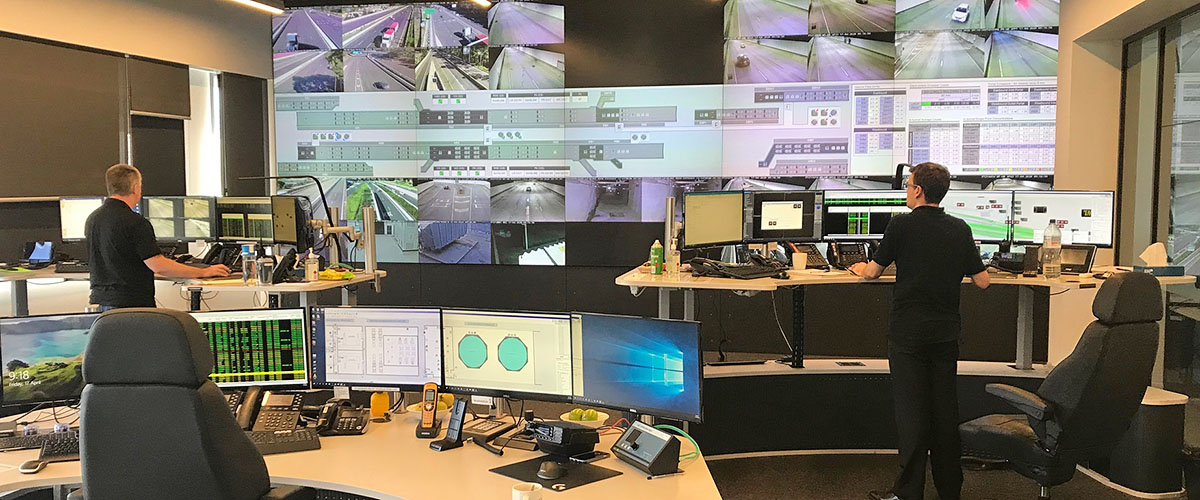As one of the world’s largest toll-road operators, everything we do works to get people where they want to go, as quickly and safely as possible. That now includes moving and supporting 3,000 team members in the middle of a global pandemic! Here’s a snapshot of our journey so far – in our offices, on our roads, on our project worksites, and in our homes.
Flexing: work life at Transurban before COVID-19
At Transurban flexible working is the norm, not the exception. Encouraging staff to work flexibly — and giving them the right tools to make it happen — has been a focus for us over the last several years.
We’ve made significant investments in flexible working technology in recent years — including advanced video conferencing and cloud-based systems that support staff working remotely, reducing the need to travel. And our offices across Australia and Northern America are designed with flexibility and agile collaboration in mind.
As a result, we were already well placed to do our jobs successfully from anywhere — even if ‘anywhere’ became the kitchen table at home.
See you on the other side: transitioning to working from home
But thousands of staff working from home at once? That was new.
We all watched as COVID-19 hit the news headlines and rapidly became a global pandemic, and our number one priority was keeping our staff and contractors, plus the people on our roads, safe and healthy.
A dedicated COVID-19 working group was established at the start of the year to assess the risks associated with the emerging pandemic and guide the business through this period. This included communicating potential operating changes to employees, customers, and other stakeholders. The group comprises experts from across the business, including representatives from our HSE, Risk, Business Resilience, Facilities, Technology, People and Culture, and Corporate Affairs teams.
Our investment in remote working technology paid off significantly, with 95% of our workforce successfully transitioning to working from home within days of government restrictions coming into effect. All of this was achieved relatively seamlessly, with our systems holding up well and providing a secure operating environment for our employees.
And our flexible working philosophy came into its own, as we focused on keeping our business-as-usual activities ticking over while managing the increased need to provide our staff, suppliers and business partners with information as the world rapidly changed around us.
View from the driver’s seat: keeping our roads open
But of course roads don’t close down during a pandemic — they’re more important than ever to transport essential workers and goods, like food and medical supplies, around our cities and across the country. (We even launched a toll credit program to support the people affected by this pandemic who needed to use our roads.)
So, while 95% of us settled into working from home, 5% of our staff continued to work from traffic control rooms and incident response hubs to ensure our roads were well maintained and the traffic on our networks kept moving safely.
We anticipated this would be a challenge well before restrictions came into effect, so we moved quickly to put special safety measures in place for these staff. These included:
- Restricting traffic control room access to essential employees only
- Reconfiguring traffic control rooms to maintain 4m2 space per person
- Mandating a limit of two staff per incident response vehicle (with the passenger sitting in the back seat, diagonal to the driver) when responding to on-road incidents like breakdowns or debris on roads
- Regularly cleaning common-use surfaces in offices
- Regularly cleaning and disinfecting fleet vehicles shared across a group of employees
- Assigning one operator per shift to drive specialised machinery and equipment and disinfecting touch surfaces between shifts.
Despite traffic being quieter on the roads, our incident response crews have been busier than ever during this time — we’ve dealt with everything from a toilet paper truck on fire to an escaped pig in a tunnel, not to mention more common hazards like lost loads and flat tyres.
In parallel to all this our business resilience team continued to work with all our other teams to enhance and test our business continuity management procedures. These prepared us to respond effectively to any other potential disruptions caused by COVID-19 restrictions.
We’re all in this together: supporting our staff during COVID-19
Making sure our people were healthy, safe, and connected was a major focus as we adapted to this new way of work life in physical and mental isolation from our colleagues.
Here are a few things we did to further support our staff:
- Ergonomic assessments for the home office: We performed over 1,000 individual ergonomic assessments on our home-work locations and couriered out office equipment such as chairs, laptop risers, monitors, and keyboards so people could do their job safely and comfortably.
- Optimised our digital communication to stay connected, engaged, motivated, supported, and prepared: Our leaders and internal communicators worked (and are still working) to keep staff in the loop on company news and messages from our CEO. We’re also sharing each other’s experiences and home lives in ‘iso’ — whether that’s debating who has the best dog on a video call or creating a ‘pandemic playlist’. Daily updates are sent to all staff to keep everyone up to date on important company, government, and community information. All this has seen a spike in employee engagement as everyone interacts and finds new and fun ways to stay connected.
- COVID-19 info hub: An information hub was launched on our intranet where employees could access the latest information, advice, Q&A, and stories from their peers on living through isolation — including a range of support services for working remotely.
- Highlighting mental and physical health: A number of staff initiatives were introduced, such as a ‘steps challenge’ that encouraged everyone to remain mentally and physically active throughout the pandemic. Chair yoga also became popular.
- Leading by example: From our CEO, to our executives, to people leaders and individuals, we shared how we were managing and balancing our work and home life responsibilities.
- Supporting leaders: Dedicated training and peer support was made available to people leaders to help them manage their virtual teams and engagements.
- Regular check-ins with each other that went beyond work: Employees were encouraged to keep in touch with colleagues by arranging things like daily or early-bird coffee catch-ups via Webex (our internal messaging and video conferencing platform) as well as other social, non-work calls that included quizzes, games, and happy hours. All told we’ve seen a three-fold increase in Webex usage since March.
We also established a number of employee support groups in Webex, including:
- the Transurban Fitness Group who catch up for quick, 10–15-minute daily workouts,
- the Transurban Lockdown Generation who are a parent support group that swap tricks and tips on social isolation while juggling working from home and home schooling their children, and
- various coffee and happy-hour groups to keep the connections going.
According to a recent staff survey our response to COVID-19 has been received positively, with an overall score of 88% favourable. Not just that:
- 91% said company communications sent to staff were timely and relevant,
- 91% stated they feel supported by their people leaders to manage their health and wellbeing,
- 89% said they have what they need to work productively at home during these unprecedented times, and
- 80% felt connected to their team and colleagues.
Hard hats and hand sanitiser: social distancing on project construction sites
While the world isolated, work continued on our major projects. Major works progressed on projects such as WestConnex and NorthConnex in Sydney and the West Gate Tunnel Project in Melbourne — all in line with government restrictions.
If you’ve ever stepped foot on a construction site, you’ll know that safety is the number one priority. While COVID-19 is with us, a number of additional safety measures have been implemented by our contractors across work sites to protect the workforce and ensure we can keep building. Some of these include:
- Working in smaller groups and restricting movement of workers across different construction sites to minimise potential of virus transmission
- Increasing sanitation of shared spaces such site offices, lunchrooms, and site sheds
- Maintaining physical distancing while working and engaging on site
- Increasing supply and use of personal hygiene products, such as hand sanitiser
- Staggering meal breaks, as well as start and knock-off times
- Utilising analytics to monitor safety and environmental trends to provide an early warning of emerging issues or potential distractions that might affect work teams.
Construction teams across all our major projects are completing an impressive amount of work despite these stricter occupational health and safety measures and the challenges they face due to physical distancing requirements.
Are we there yet? A safe, responsible, flexible return to the office
As Federal and State governments have begun to ease restrictions, we’re rolling out our own plans for the transition back to our offices.
With 22 Transurban offices in four countries, there’s no one-size-fits-all approach for our return, so plans are being tailored state by state.
Our approach to return staff to the office was developed with the health, safety, and wellbeing of staff in mind — acknowledging that returning to the office may present some personal health and logistical concerns.
Following government advice and guidelines, a safe, responsible, and flexible three-stage return to workplace will be rolled out over the coming months.
- Stage 1 will see a small number of employees returning to the office. These are people who have a business priority, or whose activities, tasks, or circumstances would benefit them being back in the office.
- Stage 2 will take learnings from Stage 1 and see a gradual increase in the number of employees in an office location, with physical distancing rules maintained.
- Stage 3 will be dependent on the lifting of all or a number of restrictions and will see us returning to ‘business as usual’ with all staff returning to office-based work.
Are we there yet? The simple answer is no. Returning to a ‘new business as usual’ may be a while away, but we’re in no rush.
What’s heartening is that, throughout this COVID-19 crisis, we’ve been able to test out our business resilience plans in a way we could never have anticipated. And, in doing so we’ve demonstrated exactly how flexible and agile our flexible working philosophies, technologies, and employees can be. So, in among all the turmoil the world is going through right now, that’s a silver lining we’re happy to see.


